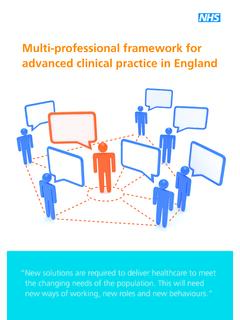Transcription of Advice on acute sector workforce models during COVID-19
1 Classification: Official Publications approval reference: 001559 Advice on acute sector workforce models during COVID-19 10 December 2020 This guidance is correct at the time of publishing. However, as it is subject to updates, please use the hyperlinks to confirm the information you are disseminating to the public is accurate. 2 | Advice on acute sector workforce models during COVID-19 This guidance has been developed by NHS England and NHS Improvement with Health Education England Contents 1. Foreword .. 3 2. Maintaining acute services.
2 5 3. Meeting the workforce requirement for the Phase 3 response .. 8 Annexes ..13 Annex 1 Staffing enhanced and critical care 13 Annex 2: Medical workforce planning and deployment to support surge service delivery: HEE support .. 18 Annex 3: Potential groups of staff to provide critical care nursing .. 18 Annex 4: Redeployment of healthcare science staff to support critical care, high dependency units and those on oxygen therapy .. 23 Annex 5: A framework for organising the allied health professions acute sector workforce to meet the Phase 3 COVID-19 .
3 24 Annex 6: A framework for organising the acute sector pharmacy workforce to meet the Phase 3 COVID-19 .. 30 3 | Advice on acute sector workforce models during COVID-19 1. Foreword At the end of July, we asked local NHS systems to prepare for Phase 3 by: planning to restore all urgent and routine services delivering extensive flu (and in due course COVID-19 ) vaccination programmes managing the expected second surge in COVID-19 infections, now here and recognised in the decision to return the NHS to the highest level of emergency preparedness (level 4) from 5 November.
4 This document was developed by NHS England and NHS Improvement with Health Education England to provide an advisory framework to help support trusts to organise their workforce in a way best suited to deliver their Phase 3 plans and can be flexed to local circumstances, resources and demand. It is, of course, still for individual employing organisations and trusts to make appropriate decisions about staff models and care. With the need to maintain acute , elective and screening services as far as possible, as well as the future pipeline of staff, the significant workforce boost to critical and acute care from redeploying staff from elective and outpatient services as well as trainees and students is not available this time, unless COVID-19 demand is extremely high.
5 Local systems are moving to expand critical care and enhanced care capacity so they can continue to deliver non- COVID-19 acute services and major surgery, as well as having enough capacity to meet their projected COVID-19 demand. This advisory framework includes updated guidance on acute sector staffing for both COVID-19 and non- COVID-19 areas, taking into account learning from the first surge. 4 | Advice on acute sector workforce models during COVID-19 We are very grateful for the contribution all NHS staff are making during this difficult time.
6 We want to help local systems support staff through this winter, both for their own health and wellbeing and that of their patients. Professor Stephen Powis National Medical Director NHS England and NHS Improvement Ruth May, Chief Nursing Officer for England Professor Mark Radford, Chief nurse , Health Education England and Deputy Chief Nursing Officer for England Professor Wendy Reid Executive Director of Education and Quality and Medical Director Health Education England 5 | Advice on acute sector workforce models during COVID-19 2.
7 Maintaining acute services Key actions for acute providers Assess the clinical workforce required for services needed over winter, both in acute hospitals and expansion facilities, taking account of advisory guidance (included here) on critical care. Funding has been allocated to regions to support time for training additional staff for new roles in critical or enhanced care. Deliver additional workforce supply from the sources identified (including Bringing Back Staff regional hubs and NHS Professionals). Embed ongoing risk assessments as part of workforce planning and ongoing discussions with staff.
8 Maintain the health and wellbeing of the whole workforce , working with staff-side bodies at all levels of the system to secure a consistent provision of practices and services that support this: Local case volumes and mix, skill mix, establishment levels and absences due to sickness and self-isolation are likely to fluctuate rapidly during the acute phase of the second COVID-19 surge. This section sets out learning from Wave 1 alongside the expectations and challenges around maintaining and restoring non- COVID-19 services for the teams which are most involved in supporting COVID-19 services.
9 Emergency department (ED) team ED teams are adapting to deal separately with patients who have suspected or confirmed COVID-19 infection and patients with other emergency conditions. All major specialties should identify a consultant, as first on call, to offer rapid senior specialist Advice to the ED team and to help minimise avoidable emergency admissions. The Care Quality Commission (CQC) has published Patient FIRST, an online resource to help ED teams, trusts and the wider system to build on the positive changes from the first peak of the pandemic.
10 For example, EDs may find it useful to route minor injuries elsewhere, eg to the fracture clinic, with appropriate staff support. Adult ward teams Medical staffing on non- COVID-19 wards should be kept at a level that maintains patient safety and optimises patient flow with regular input from senior decision-makers and support from a coherent wider professional team. Infection prevention and control (IPC) precautions (including twice-weekly asymptomatic staff testing and patient PCR tests on admission, at day 3, and day 5 6 | Advice on acute sector workforce models during COVID-19 and prior to care home discharge) are key to reducing the risk of transmission of COVID-19 infection from asymptomatic carriers to patients and staff and may be more challenging to maintain in the general wards and during activities such as shift handovers.











